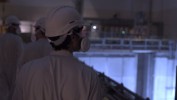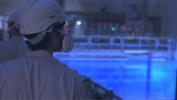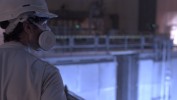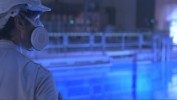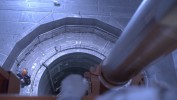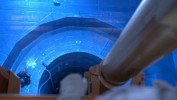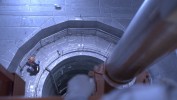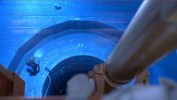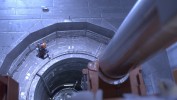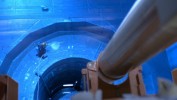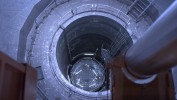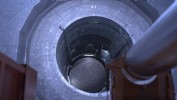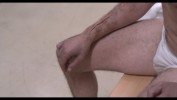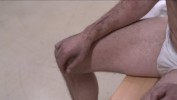GRAND CENTRAL
DIRECTOR : Rebecca Zlotowski
PRODUCTION : Les Films Velvet
VFX PRODUCER : Marguerite Moreau de Lizoreux
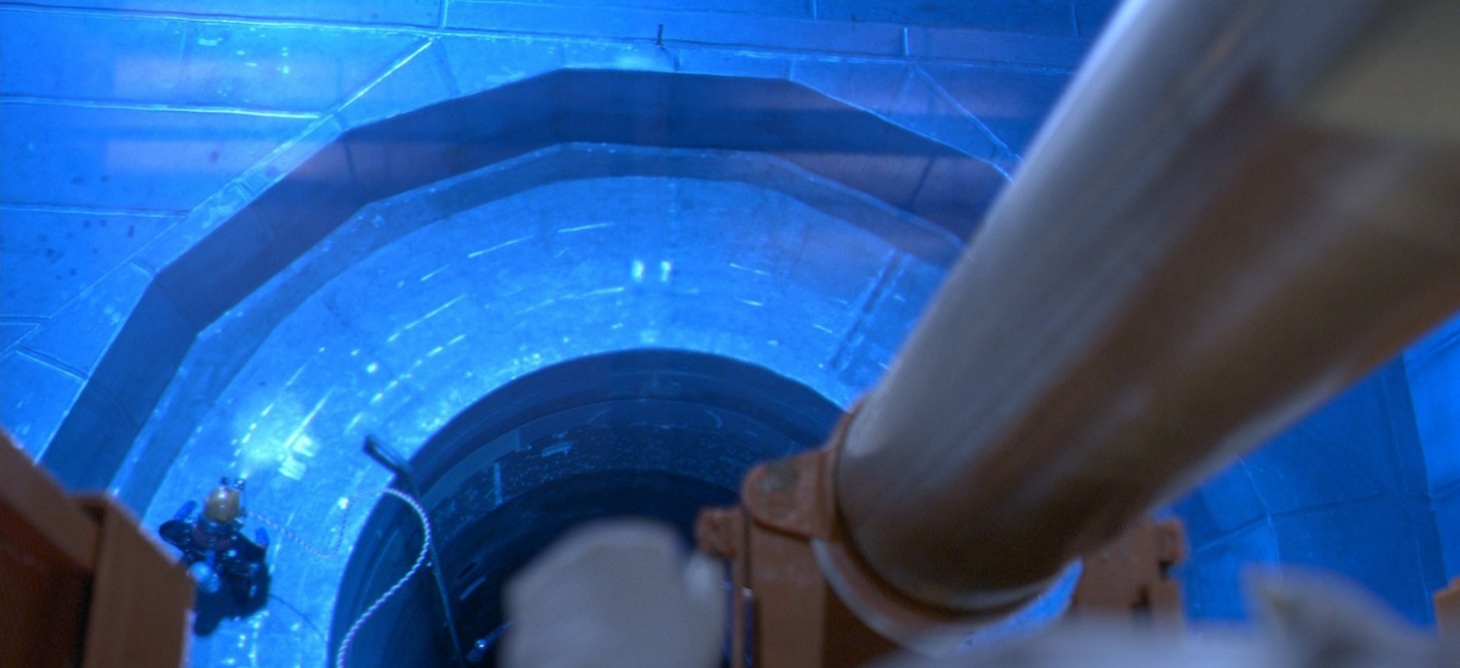
NUMBER OF SHOTS : 29
Production notes
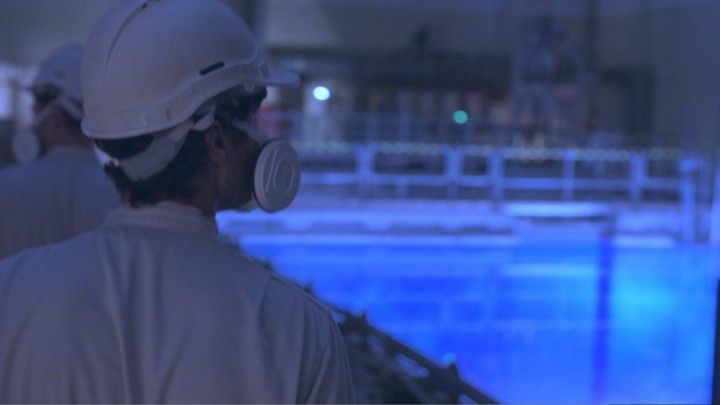
NUCLEAR POWER PLANT SHOTS (4 shots)
Shot in a nuclear power station in Austria that never became active, the idea for that sequence was to create in CG both the water that cools down the nuclear reactor inside a 7 meter deep tank, and the reactor itself that did not exist on location. As the main character Gary and his co-workers walk around the nuclear pool filled with fluorescent blue water, the reactor at the bottom of the pool is revealed to us.
The challenge for the water in terms of visual effects was to make the audience believe that the water was real although in most of the documents we found about nuclear cooling pools, the water always looked a bit sci-fi so much the colors were extreme and saturated compared to any ordinary pool. The first thing we did to achieve that is put a cold and blue type of lighting on set, at the bottom of the pool that would also create interactive lights on the actors. All the reflections on the metal panels of the tank then became blue and it helped us integrate the CG water later in post. VFX Supervisor, Fabrice Lagayette, also gathered information about the environment around the pool, such as measurements to recreate the set in CG, and 360 degrees pictures to recreate both the set lighting in CG and the reflections onto the CG water surface. When the BUF team started working on those VFX shots, the first step was to give director Rebecca Zlotowsky still frames of each shot with several color proposals for the CG water (from a green blue to a saturated blue) to make sure we were as close as possible from the final grading she wanted and that compositing would go well. Then, we worked on having the good placement for the reflections on the water surface and the correct amount of imperfection and light undulations to understand there was water although extremely static.
The other challenge for that sequence was the top shot of the nuclear reactor. Again, we had to create CG water but we had to keep it as clear as possible and still feel it was there. Rebecca Zlotowsky really wanted the audience to be able to easily read the diver at the bottom of the pool and the reactor. Thus, we had to be very subtle with the reflections we put on the water surface and gave several options to Rebecca for their amount (most of them were the ceiling lights).
We also designed the reactor based on a visual reference chosen by Rebecca adding details and textures. Then, we added a CG tube to the diving suit for the diver to breath and a headlamp that would guide him while cleaning the pool. The animation of the tube had to be slow enough to feel the weight of the water around it and the lack of gravity.
“MANO NEGRA” SHOTS (2 shots)
The Mano Negra shots were about continuing the so called effect done on set on the first shot, and fully creating it for the second shot. The effect is like a fade out to black but done with a hand closing up in front of the lens until the circle shape it does is fully closed and therefore the frame becomes black. Very progressive and slow, it also creates erratic vibrations since the hand is not very stable. That is what BUF artists had to create on one shot for which the Mano Negra effect did not go to full black and replicate on another shot for which the effect had not been done on set at all.
WOUND SHOTS (3 shots)
At some point in the movie Gary is stabbed to the arm and keeps a deep and dark cut on his right forearm. The wound is visible in 3 shots that required VFX work as the makeup was a little over played. BUF reduced the depth of the cut, its shinny aspect, and made it thinner. The goal was to make it look more subtle and more real adding back the actor’s hairs on his forearm right around the wound that had been covered by the silicone makeup. A CG forearm has been modeled and tracked into each of those 3 shots, applying the new texture of the wound. The most challenging shot was the one at the end of the movie which is quite long and has many light changes while Gary is walking towards camera swinging his arms during the whole shot.
RESTORE SHOTS ( 17 shots)
1 Tattoos
In several shots Gary had a small temporary tattoo on his left arm that needed to be removed because the final cut of the movie no longer showed how it had gotten there. These were easily painted out in comp.
2 Logos
Two exterior shots of a nuclear power plant with recognizable logos had to be restored for the power plant to be anonymous. Again, this was done in compositing quite quickly because the shots were very short.
3 Reflection
It often happens that if the camera crew is shooting straight at a window or a reflective surface on set, it ends up being in the frame and post-production becomes necessary. That was the case in one of the shots of this movie when shooting a close up of a car at night. BUF has had to paint the crew out of the reflection.
4 Boom
BUF also restored booms in two shots as it was getting into frame now and then.
STABILIZATION (3 shots)
Hand held shots on a small screen can be okay although camera shakes very much but when it comes to seeing those on a much bigger screen it can be hard to stand for the eyes. A few hand held shots of Gary at the train station had to be stabilized 50% to avoid the audience having difficulty reading the action. It was not possible to stabilize them more because the motion blur in the original plate (each time the camera would shake) would have created some strange optical effect that was not wanted.
CREDITS
BUF also finalized the Beginning and he End Credits of the movie, finding the right speed for the credits’ animation and creating a depth of field effect on the background images seen during the first part of the End Credits. Director Rebecca Zlotowsky wanted the background to be less sharp and present against the red titles and credits. Giving her several options for the effect we kept in mind that it could not be too complex or too hi-tech visually and that an optical effect would be more appropriate. Playing with the depth of field, we made it change slowly at several moments to either bring one plate or the other depending on what was happening in each one of them.



